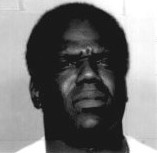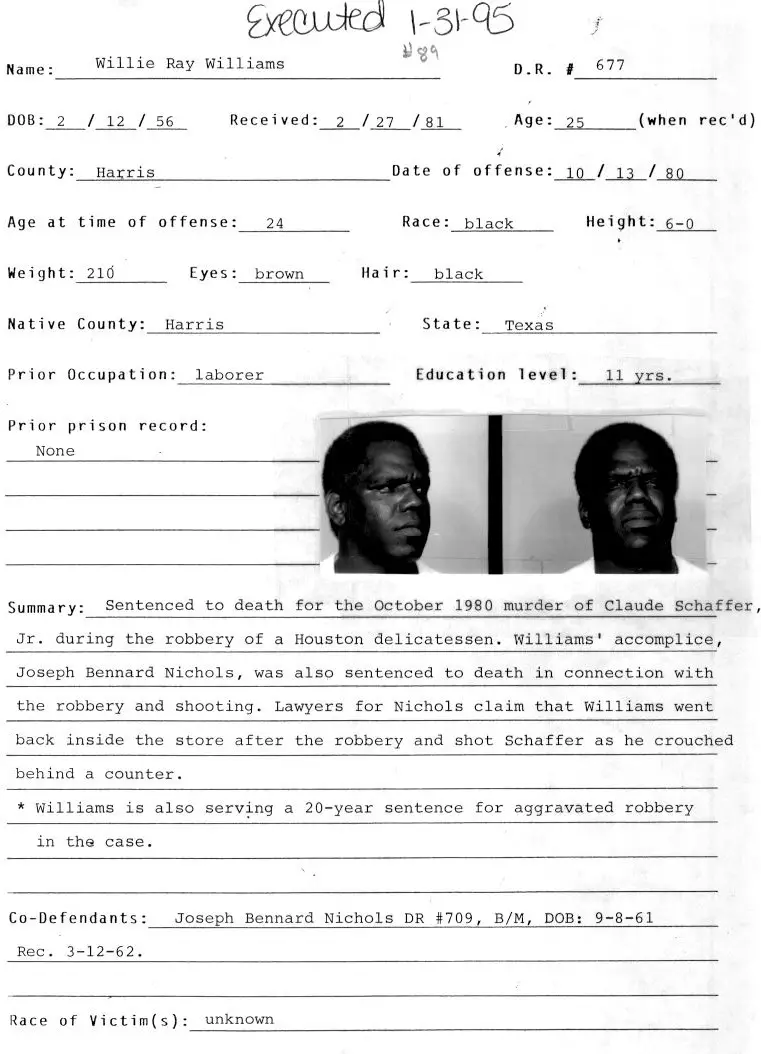Facts of the Crime
On
October 13, 1980, Nichols and Willie Ray Williams drove to a spot
near Joseph’s Delicatessen and Grocery in Houston and entered the
deli. Williams was armed with a .380 semi-automatic pistol; Nichols
had a snub-nosed .38 revolver. Both men pointed their pistols at
deli employee Claude Shaffer, Jr., who was behind the counter near
the cash register.
When Shaffer saw the guns he
began to bend over or squat down. Both Nichols and Williams then
opened fire on Shaffer, who collapsed behind the counter. Deli
employee Cindy Johnson testified that she was watching Shaffer after
Nichols and Williams pointed their guns at him and that Shaffer
never reached for a gun that he kept under the counter.
Investigators found a fully loaded .45 semi-automatic
pistol on a shelf under the counter. There were no fingerprints on
it and no .45 caliber fired bullets or empty shell casings were
found.
After firing at Shaffer, Nichols and
Williams ran to the door and Nichols went out. Williams either
exited or partially exited and then turned and fired once more at
Shaffer. Williams went behind the counter and grabbed the deli’s
cash box, then ran out of the deli with his gun and the cash box.
Nichols and Williams then joined co-defendants Charlotte Parker and
Evelyn Harvey in a waiting car and drove away. Nichols told Parker
and Harvey “he had shot the man” and “he thought he shot him in the
chest,” and that Williams said he had run back into the deli and
shot the man again. A few days later, Williams, Nichols, Parker, and
Harvey were arrested.
Willie Ray Williams was one of those young
kids who got mixed up with the “wrong” crowd. He was only 17 by the
time he was convicted of capital murder and sentenced to death. By
that time he had already committed six other robberies that are
known about. He already had the career of a criminal before he was
even old enough to vote.
On Oct. 13, 1980 around 9
a.m., Williams and some friends Charlotte Parker, Evelyn Harvey and
Joseph Nichols were all crammed into a blue Toyota when they decided
to rob Joseph’s Delicatessen and Grocery store in Houston. The girls
stayed parked in the getaway car down the road while Williams and
Nichols went in to rob the place. They went to the back of the store
and Williams got a quart of beer from the cooler. They came up front
and Nichols got a corn dog. They then both pulled their guns on 70-year-old
deli employee Claude Shaffer Jr. and demanded that all the money be
put into a sack.
Shaffer bent down as if to get a
sack and came up from behind the counter with a gun. Nichols got
scared and fired a shot. Shaffer then squatted down behind the
counter to hide. Williams and Nichols started to run out of the
store, but Williams turned around and saw Shaffer squatting with his
back towards him. Williams then shot Shaffer in the back, killing
him and ran back into the store to get the cash register box
containing $8 and to look and see if he had hit Shaffer.
Williams was arrested three days later and confessed to the murder.
He had a previous record that included three other robberies and
later police found out two more robberies after the deli incident.
Parker, who was a former girlfriend of Williams, testified against
him in a plea-bargain attempt she had made with the prosecutor
earlier to save herself.
“Parker really hurt
Williams case during the trial,” Blake Hall, one of Williams
attorneys, said. “She’s the one who told the police about all of the
other robberies. She only did it because she was involved and she
wanted to get off easier.”
Williams tried to waive
the jury trial, but that was impossible because it is mandatory in
all capital punishment cases. This was an unusual case because
Williams plead guilty to a capital murder case.
“I’ve never heard of that before,” Joseph A. Garnett, another one of
Williams attorneys, said. “It was strange because Williams lead
counsel, Joe Cannon, had told him to plead guilty. He thought that
since Williams committed the crime he would have a better chance at
getting life imprisonment rather than the death penalty if he did
so.”
Needless to say Williams received the death
penalty anyway. The jurors found Williams actions to be deliberate
so they gave him the death penalty rather than life imprisonment.
“We tried to appeal on grounds of ineffective assistance of counsel,
but the courts wouldn’t go with it,” Williams attorney Matt Pletcher
said. “We also tried to appeal on the petty crimes that Parker had
admitted as evidence because they were irrelevant to this case. We
tried everything, but the governor wouldn’t pardon him. I just felt
really sorry for him.”
Williams’s execution was
different from others and a first for Texas prison guards because
two people were to be executed the same day. That day was Jan. 31,
1995, the same as Clifton Russell. They were kept in separate
buildings so one wouldn’t have to see the others being rolled out.
Both were executed by lethal injection.


